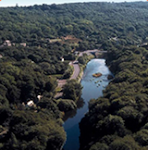
Friday, May 27 saw The Wrekin Forest Volunteers descend on Blists Hill Victorian Town Museum to survey the area of woodland, ponds and canal around the site and what a great day out it was too!
We were somewhat distracted from our task as a policeman collared a bike-thief which was very entertaining. Was that Alistair’s bike?

Jim’s obviously just left the Victorian sweet shop with a huge bag of goodies and Pete looks ready to thwack the thief around the head with his clipboard!
Onwards! We spent a very interesting day bimbling and fossicking around and found a plethora of interesting plants and invertebrates. Although the day was mainly cloudy, the rain kept off and many of our flying friends came out to play.

I’ve only recently started to spot picture-winged flies and this one (Cerajocera ceratocera) was a beauty:-
And then there was this excellent shot from Nigel of a Longhorn Beetle:-

Did anyone get a firm ID? I don’t see it in Chinery and I had a quick look on the net but couldn’t nail it. If anyone has a name please drop me an email and I’ll update this blog post.
The pond-dipping team were out in force today surveying the quality of ponds and canal. Engrossed as I was in inverts I didn’t hear the outcome of that but there was at least one very pungent pond I almost slipped into!
On the ‘leps’ front Lizze and I found many Common Blue butterflies along with a lone Burnet Companion moth and a few of us caught a lovely selection of micro-moth species - a couple of them I’m still trying to ID. But here’s one I did - was it Keith who caught this? It was one of a pair and they go by the fabulous name of Pseudargyrotoza conwagana - trips off the tongue nicely that one!

In a large wooded area of Common Nettle we found 50 or more Common Green Capsids, lots of colourful spiders were presented to Nigel, and Lizze came across an Eyed Ladybird

Lunch for some was a Cottage Pie in the restaurant but many of us couldn’t resist the prospect of savouring beef-dripping fried fish and chips. Fabulous!

The larva found on nettle was indeed as someone suggested (Les?) a Comma butterfly

I managed to find 3 species of shield bugs;- Birch, Green and a final instar Forest which I have here at home to bring through to adult.

I think between us we built up quite a list of flora and fauna and look forward to seeing the full tally once we’ve completed our final ID’s.
All-in-all an excellent day out and thanks must go to the management of Blists Hill and for Pete of course for arranging the event.
.
.
.

























